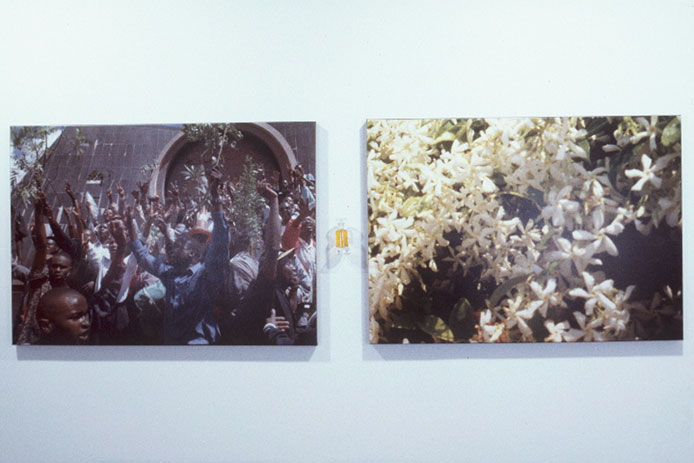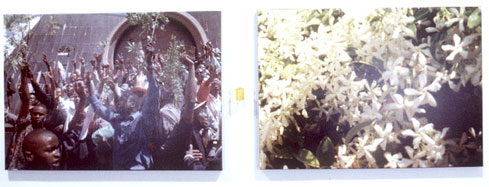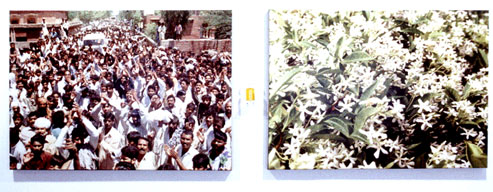One Billion, Four Hundred Ninety-Five Million, Eight Hundred Fifty-Two Thousand, Twenty-Four (1,495,852,024) (1998) is a multimedia installation that combines the aesthetics realms of the visual, the sonic, and the olfactory. The installation features a series of triptychs, named after those countries that identified a species of jasmine as their most culturally relevant scent in the World Sensorium research. Each triptych include a selected large-scale photojournalistic image of a crowd; a photographic image of jasmine shrubs taken by the artist, which simulate the crowd pattern from her memory; and an engraved bottle containing a jasmine oil composition.

Installation view of 1,495,852,024 at the Steffany Martz Gallery, New York.
The images of crowds were researched for their unique qualities in showing large-visual-field human portraiture and the different socio-dynamics of massing events. Each image was selected because it reveals a crowd mind, the fusion of individual minds to form a collective that operates as a single organism. The psychology and emotions of the event define the physical patterns of massing. The photographic images were examined for representations of texture, scale, dimensions and overall composition in an attempt to commit them to memory in order to explore the ability to recall and recreate massing compositions in other visual fields, thereby establishing a more formal aesthetics of mass anatomy. The images were also analyzed for the implications of their narrative, social commentary and visual meaning so as to aid their reproducibility.
Jasmine shrubs were selected as the alternate visual field. Jasmine is the scent with the highest cultural status in proportion to the world’s population: it has been identified as the most significant natural scent in China, Pakistan, Algeria, Kenya, Saudi Arabia, Tunisia, Paraguay, Macau, and Djibouti, together representing 1,495,852,024 people, or 24.5862% of the world’s population in the year 2000, more than any other single aroma. The massing patterns of the crowd photographs are simulated in patterns made by the blossoms, leaves, and branches of the jasmine shrubs photographed by the artist in the south of France.
Between the massing image and the photograph of the jasmine shrub, a bottle containing a jasmine essential oil composition was mounted, engraved with the name of the country in which the massing portrait was taken and the number of people in that country.

Algeria Jasmine Triptych, 1998, comprised two digital oil-emulsified ink canvas prints (each 30 x 42 inches) and a 2.2 oz. bottle containing jasmine essential oil (the front was engraved with Algeria 31,787,646, and the back engraved with 1,495,852,024).
The primary aesthetic concern of these works was to demonstrate the relationship of crowd behavior and the overall composition of the massing portraits, i.e., the patterning created by the individual bodies, to the ability to detect encoded patterns that are possibly “hard-wired” in some way in the human brain. By juxtaposing crowd images with representations of natural forms, the artist sought to explore how these embedded patterns are repeated across crowds globally and also replicated in nature. In this way, the Jasmine Massing triptychs formed another step in the exploration of the aesthetics of mass anatomy.
In addition to the triptychs, the installation included a scent composition of different species of jasmine, which suffused the gallery space. A sound-art piece of breathing in a 7:1 pattern, entitled Breath, Essence, and (After)image, was played at a barely perceptible level. The auditory pattern enhanced the sensory awareness, serving as a cue to convey the message of experiencing an artwork through inhaling: that is, indexing the scent through the sound of breathing.

Gayil Nalls recording breathwork for the CD edition of
Breath, Essence, and (After)image, which was
created to heighten olfactory sensory experience.
The significance of One Billion, Four Hundred Ninety-Five Million, Eight Hundred Fifty-Two Thousand, Twenty-Four (1,495,852,024) to World Sensorium lay not only in the precursory nature of the installation. As a multimedia work, 1,495,852,024 also established links between massing and scent through the introduction of an olfactory element (the jasmine composition) that brought about a collective metabolic experience. 1,495,852,024 also underscored one of the main theses of Permutatude—namely, that media (here, photography rather than television or film) allow for the exponential growth of the neuroaesthetics of massing.

Kenya, (1998)
Digital Canvas Prints, oil-emuslified ink, 30 x 42 inches (each)
Jasmine Absolute, Engraved Bottle, 2.2 oz (60g)

Pakistan, (1998)
Digital Canvas Prints, oil-emuslified ink, 30 x 42 inches (each)
Jasmine Absolute, Engraved Bottle, 2.2 oz (60g)

Paraguay, (1998)
Digital Canvas Prints, oil-emuslified ink, 30 x 42 inches (each)
Jasmine Absolute, Engraved Bottle, 2.2 oz (60g)